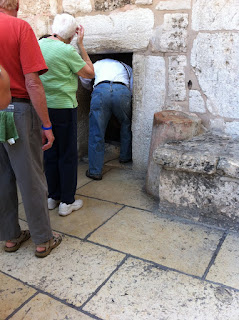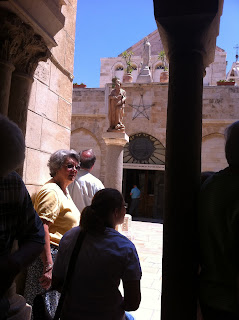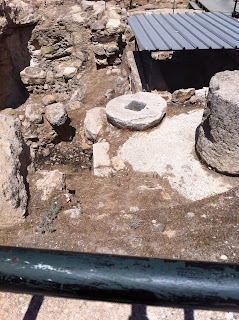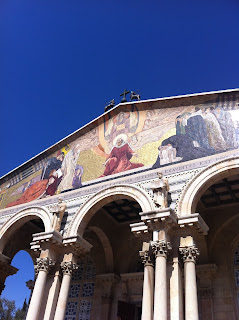I know that I am not done with my adventures in Israel, but, realistically, I am not going to finish. There is too much to write and I don't have the time. So, lets sum it up by saying I met some wonderful people, I heard some great speeches, and I am very grateful to my husband for letting me go. If you ever get a chance to go to Israel, I would highly recommend it. It is an amazing place with history as you will never see anywhere else.
Today my thoughts are geared more for what we take for granted in America and what we assume everyone gets to enjoy. I have a friend here who also writes a blog. A recent entry she made has caught the attention of several people here and she has been asked to remove it. What could be so terrible that she would be asked to take down her own thoughts and experiences? I'll tell you, it is that she made an entry about the king that some people consider inappropriate. There is a law here in Morocco that you can not make fun of the king or do anything which could be construed as ridiculing him. In her blog she poked fun at the fact that every store has a picture of the king doing something that relates to what is being sold at the store. One example is a picture of the king with chickens at a poultry store or where eggs are sold. Personally, she finds this amusing. And that is what she wrote in her blog. Now she has been asked to kindly remove the post. Worse case scenario, if the government feels it is warranted, her family will be asked to leave Morocco to return to the states. I doubt it will get to that point, but she has no intention of taking it down, either.
As I was listening to her tell her story I began to really think about what it means to have freedom of speech. Never in history have people every been able to say anything they would like against those ruling over them. Talking ill against the government would get you fined in the least and killed at the worst. In fact, in most countries today the same still applies. There have been stories coming out of North Korea lately about what kind of hell people go through whose families are accused of berating or even whispering about their government. Obviously here in Morocco it will get you jailed. In China you just disappear. In Cuba you are sent to a reeducation camp. During WWII in Germany you were whisked away to a work camp. Even here in the US, there have been several times where rights were taken away in the name of "National Security." See http://www.faqs.org/espionage/In-Int/Intelligence-and-Democracy-Issues-and-Conflicts.html
Today we have "Occupy _______" going on all over the country. People are out exercising their right to say whatever comes to their minds. Many of those down there think our constitution should be done away with and a new form of government should be installed. Not all, but many. And when asked what they would replace our current government with, socialism and communism seem to be the most popular choice. This begs the question, do those people really understand how those types of governments run? The very liberty used to voice that opinion is the FIRST freedom that will be taken. To have total control mean that there can be no dissension. Any threat to power must be done away.
We have spent the last 200+ years being able to speak our minds (minus the times we weren't). We have been able to have political discourse. People have been able to protest. And we sit back and can not grasp the fact that we are alone in that arena. Since we have those freedoms we assume everyone else does, too. That is just not true. We are the ONLY country that freedom of speech is guaranteed without repercussions.
My final thoughts. If you are accustomed to a certain way of life you think it will be like that forever. We are accustomed to freedom of speech. We assume we will always have it. But rest assured, with the right people in power, it will be the first thing to go.
Today my thoughts are geared more for what we take for granted in America and what we assume everyone gets to enjoy. I have a friend here who also writes a blog. A recent entry she made has caught the attention of several people here and she has been asked to remove it. What could be so terrible that she would be asked to take down her own thoughts and experiences? I'll tell you, it is that she made an entry about the king that some people consider inappropriate. There is a law here in Morocco that you can not make fun of the king or do anything which could be construed as ridiculing him. In her blog she poked fun at the fact that every store has a picture of the king doing something that relates to what is being sold at the store. One example is a picture of the king with chickens at a poultry store or where eggs are sold. Personally, she finds this amusing. And that is what she wrote in her blog. Now she has been asked to kindly remove the post. Worse case scenario, if the government feels it is warranted, her family will be asked to leave Morocco to return to the states. I doubt it will get to that point, but she has no intention of taking it down, either.
As I was listening to her tell her story I began to really think about what it means to have freedom of speech. Never in history have people every been able to say anything they would like against those ruling over them. Talking ill against the government would get you fined in the least and killed at the worst. In fact, in most countries today the same still applies. There have been stories coming out of North Korea lately about what kind of hell people go through whose families are accused of berating or even whispering about their government. Obviously here in Morocco it will get you jailed. In China you just disappear. In Cuba you are sent to a reeducation camp. During WWII in Germany you were whisked away to a work camp. Even here in the US, there have been several times where rights were taken away in the name of "National Security." See http://www.faqs.org/espionage/In-Int/Intelligence-and-Democracy-Issues-and-Conflicts.html
Today we have "Occupy _______" going on all over the country. People are out exercising their right to say whatever comes to their minds. Many of those down there think our constitution should be done away with and a new form of government should be installed. Not all, but many. And when asked what they would replace our current government with, socialism and communism seem to be the most popular choice. This begs the question, do those people really understand how those types of governments run? The very liberty used to voice that opinion is the FIRST freedom that will be taken. To have total control mean that there can be no dissension. Any threat to power must be done away.
We have spent the last 200+ years being able to speak our minds (minus the times we weren't). We have been able to have political discourse. People have been able to protest. And we sit back and can not grasp the fact that we are alone in that arena. Since we have those freedoms we assume everyone else does, too. That is just not true. We are the ONLY country that freedom of speech is guaranteed without repercussions.
My final thoughts. If you are accustomed to a certain way of life you think it will be like that forever. We are accustomed to freedom of speech. We assume we will always have it. But rest assured, with the right people in power, it will be the first thing to go.





















































